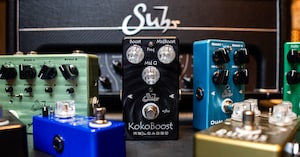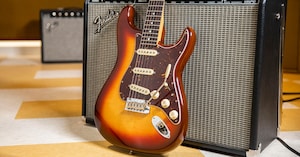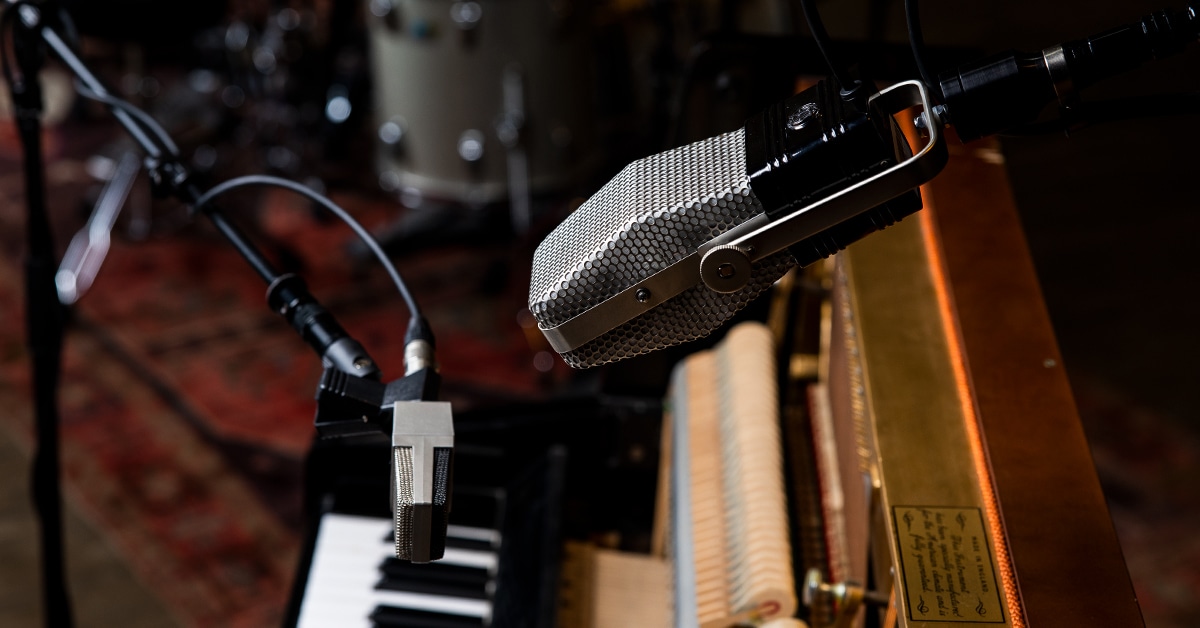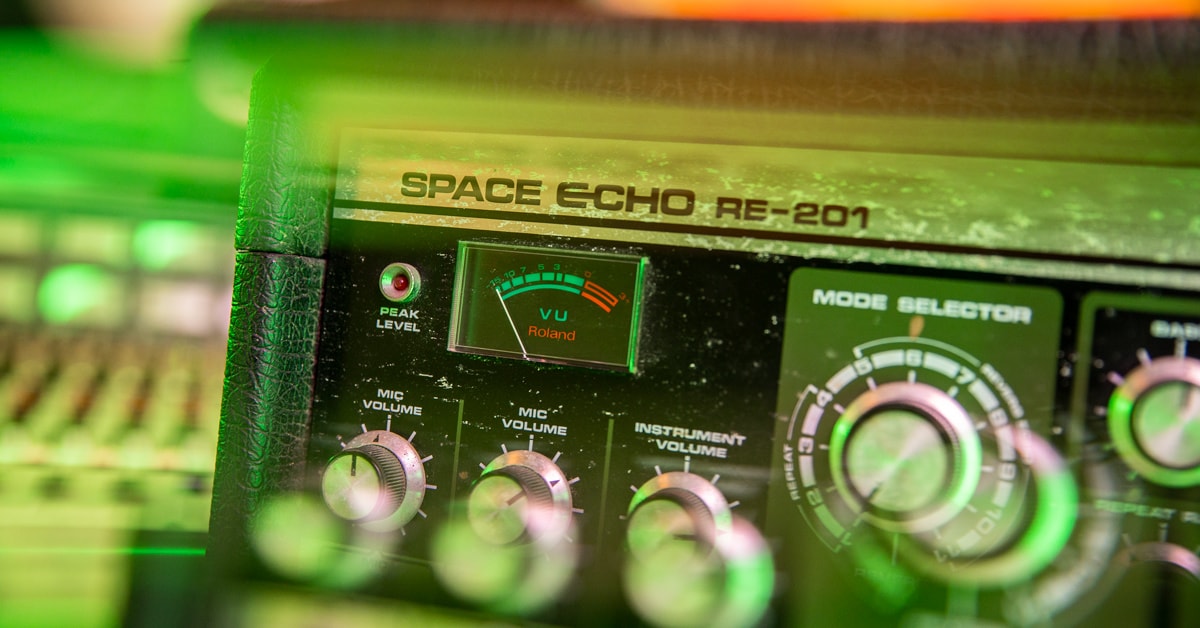From simple slapback to devastating dub tracks, using recording tape to create ambience and effects dates back to the birth of magnetic tape as a recording medium in the 1940s. The Roland Space Echo, in all its incarnations—most notably the RE-201—while not the first portable tape delay (more on that in a bit), contained so many improvements and new features that it marks a sea change in just what you could do with a tape delay, both on stage and in the studio. In this article, we'll provide a little history of tape delay in general, and talk about what made, and continues to make, the Roland/BOSS Space Echo the touchstone for tape delays.
Table of Contents
What Makes the Roland/BOSS Space Echo so Cool?
Famous Users and Recordings
Space Echo History
The Beginnings of Tape Delay
The Ace Tone Years
The Tale of the Tape: RE-100 to the RE-501
Digital Modeling Versions
Current Roland and BOSS Flavors of Tape Echo
BOSS RE-2
BOSS RE-202
BOSS DD-200/500
Pedals Inspired by the Roland/BOSS Space Echo
Universal Audio Galaxy '74
Fender Hammertone Space Delay
Wampler Metaverse
Line 6 DL4 MkII
NUX Tape Echo
Plug-ins From Space
Universal Audio UAD Galaxy
Arturia Delay TAPE-201
IK Multimedia T-RackS Space Delay
Cherry Audio Stardust 201
Shopping for a Vintage Space Echo
The Final Repeat
What Makes the Roland/BOSS Space Echo so Cool?
Ask any original, tape-based Space Echo aficionado what it is they love most about the RE-201 and all its descendants, and the first answer is likely to be the extraordinarily musical character of the sounds you get from an electro-mechanical device. That's one thing that spans all the models, both the original analog tape delays and the modeled digital versions. The sound of tape saturation and the slight imperfections that come from the nature of a mechanical transport and magnetic tape create just enough variation to keep the delays from sounding sterile, but not so much as to sound forced. Unless, of course, that's what you want, and the Roland/BOSS Space Echo can certainly go there when needed.
Up next would be the versatility of having three playback heads to chose from or combine, as opposed to the single playback head of many tape delays. This creates the opportunity to find musically useful combinations that create rhythmic interest. Besides, it's much easier to set up than using multiple separate delay units.
Next on the list is the built-in effects besides tape delay. On the RE-201, you've got the integrated spring reverb, and a very nice one at that. You want some ambience? Just dial that puppy up. On the RE-301, you get the addition of the same chorus effect as on Roland's iconic JC-120 Jazz Chorus amplifier. It's kind of a one-stop shop for time-based effects that work as well on a send/return from your mixer as they do on stage in an amplifier.

Those first two items, though, really need to be combined, as one of the RE-201 Space Echo's particular pieces of genius was the 12-position rotary switch that gave you your choice of individual or combined tape heads by themselves, with reverb, or a reverb-only setting. Combined with the two-band EQ in the box, you could spend weeks just playing with all the available sounds.
Finally, it's the dependability (not that the recent generations of digitally modeled versions have ever really had to deal with this). The Roland RE-201 Space Echo was the first tape-based delay unit that was solid enough to reliably carry around from gig to gig and not have to worry about having something go wrong. The brilliance of Roland founder and engineer Ikutaro Kakehashi's original design really shines through, even 50 years later. There's a reason why there was some version of the RE-series tape echo in regular production for almost 20 years.
Famous Users and Recordings
There are few effects that have been used more widely and across more genres than the Roland RE-series tape echo machines. From rock artists like Brian Setzer, Pink Floyd, KISS, Mick Jones, Yngwie Malmsteen and Randy Rhoads to dub/reggae artists and producers like Bob Marley, Lee "Scratch" Perry (known to play the Space Echo like an instrument in its own right) and King Tubby, it's been an invaluable tool on stage and in the studio. Portishead, Sonic Youth and Radiohead use it to help create their unique soundscapes, and producers like Tim Simenon on the Bomb the Bass single "Bug Powder Dust" and Dust Brothers on the Beastie Boys' Paul's Boutique album (among many others) virtually defined new music genres with an RE-series tape delay as part of their arsenal. Ambient producer/composers Brian Eno and Jean-Michel Jarre are big fans of the Space Echo, as was the late composer/arranger Vangelis. Scratch any genre of popular music, and it's likely that you'll find a Roland Space Echo lying somewhere in the mix.

Space Echo History
So, how did the Roland/BOSS RE-series delays get here? To understand that, we need to go back 80 years or so to the very advent of recording tape.
The Beginnings of Tape Delay
We don't know, and we may never know, who the first person was to realize that if you set up two tape machines side by side, fed the output of the first on into the second, you could get a single repeat echo effect that made it sound as if you were in a larger space (although it may have been at Capitol Studios in Hollywood). We do know that it didn't take long for word to get around, and by the late 1940s, not long after the invention of magnetic tape, it was something that adventurous recording engineers were toying with. It took the singular genius of inveterate electronic tinkerer Les Paul to craft a multi-head, sound-on-sound machine that would come to define his sound after having been gifted with an early Ampex tape recorder by Bing Crosby. At roughly the same time, Memphis record producer Sam Phillips was starting to experiment with the dual-tape machine method of getting an echo effect on recordings at his Sun Studios.
It wasn't until 1953, when inventor Ray Butts created a guitar amp called the EchoSonic that contained an all-in-one tape echo unit, that the effect could easily be attained outside of a recording studio. After the aforementioned Sam Phillips heard guitar legend Chet Atkins playing through one of these amps, he ordered one for his studio, and house guitarist Scotty Moore was soon using it to create that iconic rockabilly slapback sound (though other sources have stated that it was Moore who bought the amp, not Phillips). The EchoSonic's tape echo unit was so good that it was basically copied (with a small payment to Butts) for the original 1959 Echoplex EP-1 design by Mike Battle and Don Dixon.

While all this was happening in the U.S., across the Atlantic in the U.K. and Italy, other echo units that used magnetic media at their heart were in the works. In 1954, Charlie Watkins, who owned a small music store in London, developed the WEM/Watkins Copicat tape echo after having heard about the two-tape-deck method being used at local recording studios. Then, in 1955, Italian company Binson came out with the Echorec (for Echo Recorder), which used a spinning magnetic disk, rather than recording tape, and was the first echo unit to have multiple playback heads. So, by the early 1960s, dedicated tape echo units were in fairly common use, although each had their quirks and foibles, largely due to the amount of maintenance they required, and the care they needed to receive to keep working reliably. Our next step is a large one, to Japan, a company called Ace Electronics, and an engineer/designer/entrepreneur named Ikutaro Kakehashi.
The Ace Tone Years
Ikutaro Kakehashi founded Ace Electronics in 1960 with the initial intention of designing and selling electronic organs, and what were then referred to as "rhythm machines." From then until his death in 2017, "Taro," as he was commonly known, would be one of the most influential designers and inventors in the world of electronic musical instruments and equipment. Kakehashi pioneered much of what musicians with a bent toward the electronic side of music use today, and was a fascinating character in his own right. His autobiography, I Believe In Music, is well worth tracking down. But today, we're concerned with his contributions to the refinement of tape echo units, which started with the introduction of the Ace Tone EC-1 in 1969.
The EC-1 (EC for Echo Chamber) presaged the basic form factor that would become the RE-series, as well as the beginnings of many of the features that would be refined as the design evolved. It used a similar type of tape loop to the WEM and the Echoplex units, but had multiple playback heads, like the Echorec. The delay time was adjusted both by switching playback heads and by mechanically sliding the record head, similar to how the Echoplex slid the playback head. Rather than a rotary knob to select the playback heads, it had push buttons, and each of the three inputs—two microphone and one instrument—had input volume and a basic tone control. The EC-10, which followed shortly after, would be the first to feature the rotary-knob mode selector and variable motor speed, rather than sliding head, as a supplementary delay length change over simply switching heads. It also had five playback heads. The EC-20 was a slightly pared back unit, with no tone controls and went back to the push button head selection system. In 1972, Kakehashi dissolved Ace and started a new company called Roland.
The Tale of the Tape: RE-100 to the RE-501
The Roland RE-100 and RE-200 were evolutions of the Ace Tone EC series and were the first tape echo units created by the new company. The RE-100 was the more basic of the two. Its rotary Mode knob had six positions—the first three switching between the single playback heads and the second three providing the head combinations (1+2, 1+3 and all three heads, respectively) for what Roland was then referring to as a "Swell" effect. The RE-200 was the first tape echo unit to also include a spring reverb unit, and here we see what was to become the standard mode selection knob on the RE-series units, with the first four positions selecting delays with no reverb, the next seven selecting individual heads and head combinations, plus reverb, and a final position for reverb only. Both units still used a standard tape loop, but that, which had long been a weak point of all tape-based echoes, was about to change.

With the introduction of the RE-101 and RE-201 in 1974, the entire tape transport was changed, with a reduction in the number of failure-prone mechanical parts, the addition of a new capstan-based drive system and a new, free-running, much longer loop of tape that was only kept under tension from just before the head block until just after it, where the driving capstan was located. The tape was allowed to spool freely under a clear cover on the top of the unit. As a side note, just watching the constantly shifting snaking of the tape under this cover is remarkably trance-state inducing, at least if you survived the ’70s. As one of the problems with having had the tape path constantly under tension in earlier tape echoes was the tendency of tape to stretch and/or break under that constant tension, this change greatly reduced the frequency with which it had been necessary to replace the tape loop. This also required either buying a replacement loop from the manufacturer, or carefully measuring and splicing your own tape. The new system didn't really require the loop to be of a specific length other than long enough to run all the way through the tape path, so it made it much easier to replace on the go.
As we mentioned previously, the RE-101 and 201 were the first tape echo devices that were sturdy and reliable enough to trust on the road without kid glove treatment. Brian Setzer has been quoted as saying the reason he started using the RE-201 was precisely because he could count on having it work from night to night on stage. So, many artists who had been using tape delays in the studio started taking them on the road. Another feature, though one that is, in a way, incidental—but well worth mentioning—is the internal preamp in the Space Echo units. It had just enough gain to be able to add a little extra punch, or even grit, to your signal. It also served as a buffer to help preserve signal and tonal quality from your source signal, whether from guitar, microphone or some other instrument. Plus, it added an indefinable musicality to the overall sound. Like the preamps on other tape echo units (notoriously the Maestro EP-3), for many users it became an "always on" processor, which is why every modern modeled version of the Space Echo family takes pains to get the preamp right.
The next step was the RE-301, introduced in 1977. The RE-301 was dubbed the Chorus Echo, rather than Space Echo, because it had Roland's chorus circuit—which was also featured in the JC-120 Jazz Chorus amplifier—added, as well as a sound-on-sound looping function, another Roland first. In 1979, a simplified version of the RE-201—the RE-150—was released. The RE-150 only had two playback heads instead of three, but it added separate dry and wet outputs.

The RE-501 Chorus Echo, and its rackmountable sibling, the SRE-555 ("S," we assume was for "Studio"), were the final models that were tape-based. They added a fourth playback head, switched from an analog VU meter to an LED-based one and, maybe most importantly, had redesigned audio circuitry that greatly reduced the noise. They took the basic features of the RE-301 and added balanced XLR input and output, while going back to a six-position rotary knob that selected only individual heads or head combinations, as the reverb, chorus and sound-on-sound switching was on push button switches. They also switched from the familiar black and green faceplate design to an all-black face that was more in line with the rest of the then-current Roland product line. But they were the end of an era, and the new digital delays were much more in demand than that old-fashioned, analog tape stuff with its constant need for mechanical maintenance and regular replacement of the tape loop (speaking of maintenance, we'll be coming back to that in the section, "Looking for a Vintage Space Echo"). It would be close to 15 years before the next RE-series Space Echo would appear, and that would be from Roland's subsidiary company, BOSS.
Digital Modeling Versions
For most of the 1990s and the first part of the 2000s, if you wanted classic Space Echo sound and vibe, you had to peruse the used market. But, in 2007, BOSS used Roland's COSM (Composite Object Sound Modeling) technology to create a new, conveniently pedalboard-sized incarnation of the Space Echo, the BOSS RE-20. Duplicating the RE-201's feature set, the RE-20 added some modern conveniences like stereo operation, tap tempo and expression pedal control, so you didn't have to lean over and twist a knob to get that runaway echo effect that had been made popular by dub and reggae producers. The Space Echo was back, baby, and in a major way.
Current Roland and BOSS Flavors of Tape Echo
The RE-20 isn't the end of the story. Roland/BOSS has continued to refine their modeling, and in 2022, released the RE-2, a compact version of the RE-20, and the RE-202, a no-holds-barred updating and expansion of the RE-201 feature set. In addition, a number of their other pedals and multi-effects units have Space Echo models included. Let's take a quick look at the current lineup.
BOSS RE-2
The BOSS RE-2 Space Echo is the perfect pick if you're short of pedalboard space, but still want the full RE-201 vibe and sound. BOSS manages to pack it all into a single, standard-sized pedal by using stacked pots and a well-thought-out UI. The modeling even includes such subtle touches as variations between the response of individual virtual playback heads. With a true stereo in and out, plus the ability to switch between a "straight-through" mode or use the modeled RE-201 preamp, this compact pedal puts all that classic delay goodness at your toetips.

Pictured: BOSS RE-2 Space Echo
BOSS RE-202
Stepping up to the next level, the BOSS RE-202 Space Echo may take up a little more space on your pedalboard, but the expanded feature set is well worth the need for added real estate. The RE-202 adds one more virtual playback head—that's a total of four playback heads—for even more variety. Other new and expanded features include the ability to change the distance between the virtual playback heads, a tape saturation control, four memory presets available directly from the unit (with another 123 available via MIDI), the ability to control multiple parameters at once via expression pedal or MIDI, Warp and Twist modes, and much, much more. BOSS studied a number of vintage RE-201 units in the process of creating this versatile delay pedal. The expanded feature set doesn't get in the way of the straight-ahead vintage vibe if you stick to the basic features, but it lets you do so much more that a number of die-hard original RE-201 users have been switching over to the RE-202.
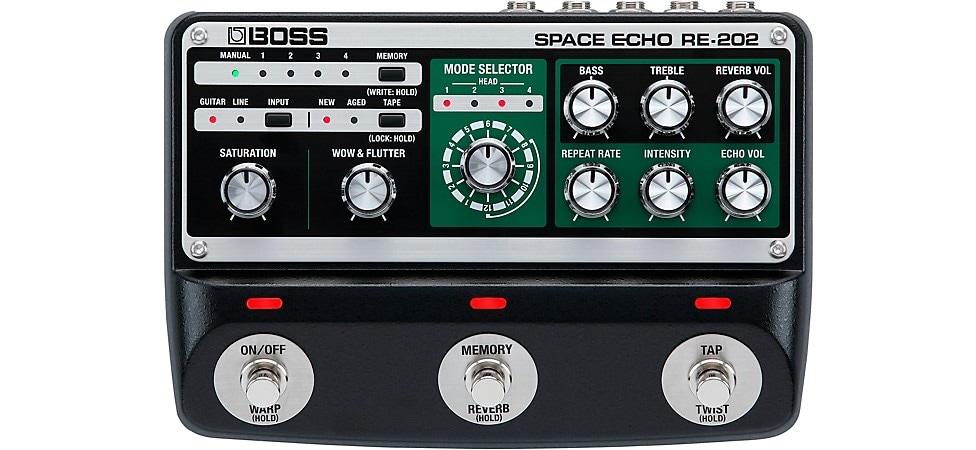
Pictured: BOSS RE-202 Space Echo
BOSS DD-200/500
Before we step away from the Roland/BOSS world, we have to mention the BOSS DD-200 and DD-500 digital delay pedals. While not specifically Space Echos, both of these versatile delay pedals contain Space Echo models as part of their feature sets, as well as a wide variety of other delay types and an integrated looper feature. If you love delay effects and want a variety of them easily available on your pedalboard, you can't go wrong with either of these.
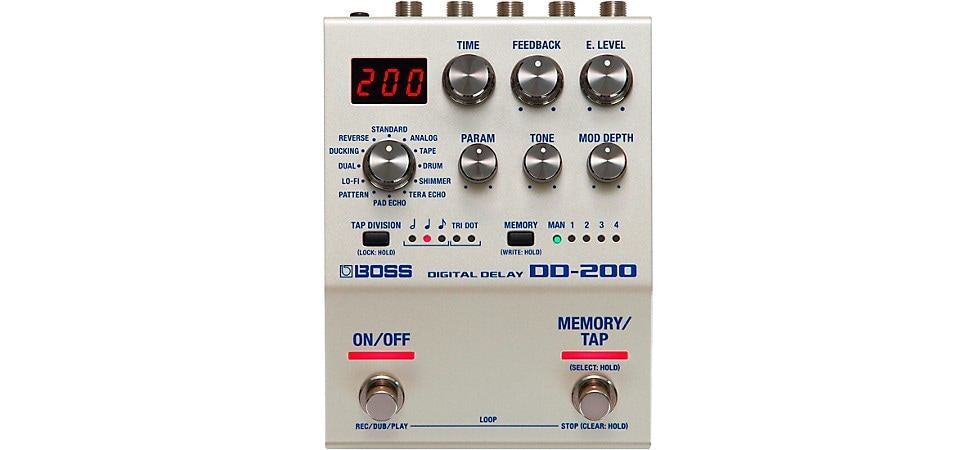
Pictured: BOSS DD-200 Digital Delay
In addition, many of the Roland/BOSS multi-effects pedals have Space Echo models as part of their feature set, as well as some of their music production tools, like the Roland SP404MkII Sampler and Effector. As jazz iconoclast Sun Ra used to say, "Space is the place."
Pedals Inspired by the Roland/BOSS Space Echo
The Roland Space Echo family has achieved such an iconic status that it's no surprise that many other companies have been inspired to create their own versions of the feature set and sounds. Let's take a little closer look at a handful of them.
Universal Audio Galaxy '74
Universal Audio has been taking their DSP expertise to the world of effects pedals, and in the Galaxy '74, have created an emulation of everybody's favorite '70s tape delay unit. It's all here—three playback heads, reverb, stunning emulations of tape saturation and electro-mechanical wow and flutter—everything you need to grab the vibe and start playing with it. A key to the audio quality here is UA's award-winning UAFX dual-engine processing, which runs separate stereo instances of each reverb and delay, creating an almost three-dimensional sound field.

Pictured: Universal Audio Galaxy '74 Tape Echo & Reverb
Fender Hammertone Space Delay
The Fender Hammertone Space Delay is definitely in the "inspired by" category more than a full emulation. The pared-back feature set is closer to an RE-101 than an RE-201, as it has no reverb, but it's not really trying to be a full-fledged Space Echo, though it does offer a similar set of "playback head" configurations for rhythmic patterns in the delays. It aims more at the ambient world and is definitely on the more affordable side of the equation here. If you're just starting to repeat yourself, this pedal would be a great place to start.

Pictured: Fender Hammertone Space Delay
Wampler Metaverse
The Wampler Metaverse multi-delay pedal delivers a whole world of emulated delays from pristine digital and janky bucket-brigade low-fi sounds to some excellent tape delay emulations. One of those is a very nice tribute to the Space Echo, with, as Wampler puts it, "Brian’s unique self-oscillating multi-dimensional take." If you're looking for a wide variety of delay types to work with and want to include a Space Echo flavor as part of it, this is an awesome pedal to slap on your board.
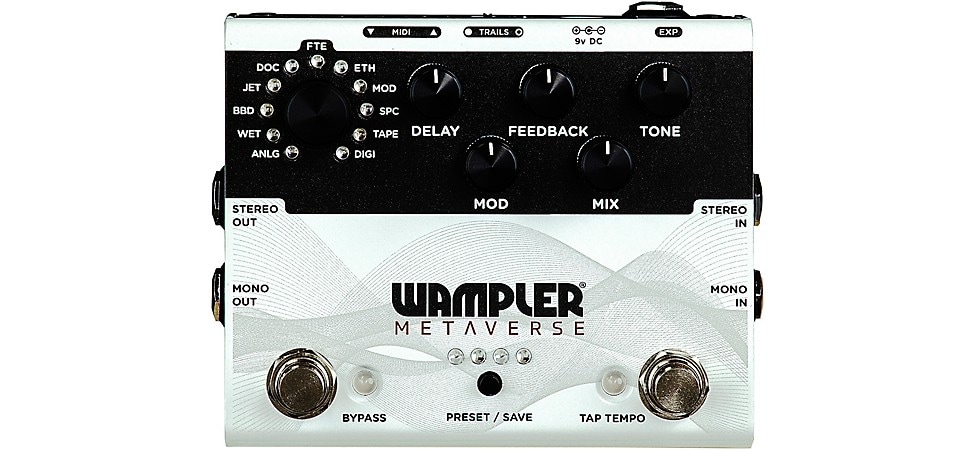
Pictured: Wampler Metaverse Multi-Delay
Line 6 DL4 MkII
The original Line 6 DL4, in all its Art Deco, retrofuturist-inspired greenness, started the trend of multiple delays in a pedal, and the MkII version just kicks that up a notch. There are actually two different emulations of the Space Echo inside this box, the "Multi-Head" legacy delay from the original DL4 and the HX-technology "Cosmos" delay. Once you get used to the shifting functions of the "Tweek" and "Tweez" knobs, you can easily dial in a great-sounding Space Echo simulacrum, and still have 28 other delay types at your fingertips.
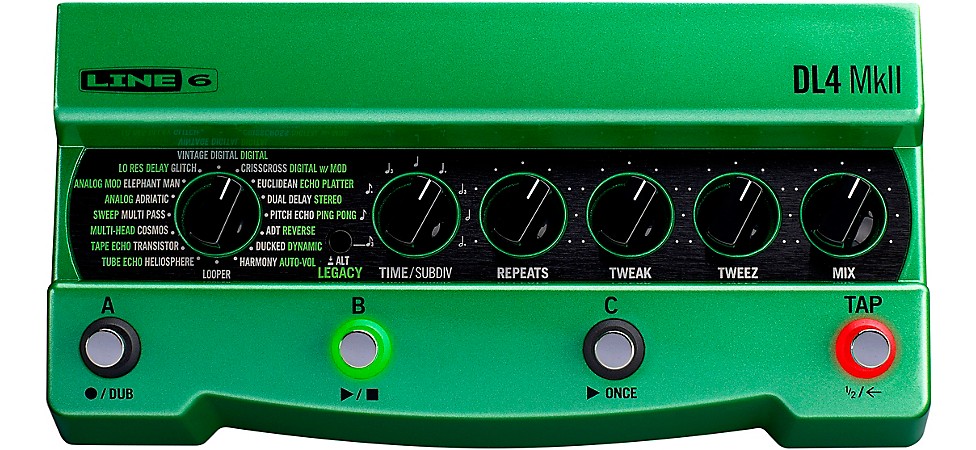
Pictured: Line 6 DL4 MKII
NUX Tape Echo
The NUX Tape Echo aims squarely at the RE-201's feature set, using their Core-Image technology to recreate all the analog quirkiness of the Roland classic. Like the other modeling pedals, it adds a few extra bells and whistles, like a looper, tap tempo, MIDI control and expanded delay times. It's also on the more affordable side for a full-blown Space Echo model. So, if you want the vibe but are on a budget, check this one out.

Pictured: NUX Tape Echo
Plug-ins From Space
Due to its iconic status, the RE-201 has also been a target for many audio plug-in manufacturers, with some truly excellent choices for your DAW as a result. Most have gone for some spin on the look of the original hardware unit, and a number of them have added unique twists on some of the features or added entirely new features that greatly increase studio flexibility. An added plus for plug-ins is the ability to create automations that are always exactly, um, repeatable.
Universal Audio UAD Galaxy
Universal Audio's UAD Galaxy plug-in is designed to be a straight-ahead, feature-for-feature recreation of a 1974 RE-201. It's available in both a native version or one that runs on dedicated UAD DSP. It nails all the subtle imperfections that make up the charm of the original hardware, with the added features of being able to emulate the age of the tape loop and sync delays to your DAW's tempo, as well as control panning on both reverb and delay.

Pictured: Universal Audio UAD Galaxy Tape Echo Plug-In
Arturia Delay TAPE-201
Arturia's Delay TAPE-201 plug-in, at first glance, looks like a pretty direct emulation of an RE-201, but click on the "Advanced" button, and you'll find some cool additions to the standard feature set. These include a three-band, quasi-parametric input EQ; control over flutter, tape noise and motor inertia to simulate tape and mechanical age; and an LFO (low frequency oscillator) with multiple waveforms that can be assigned to modulate almost every available parameter of the plug-in. That last makes for the possibility of some incredibly trippy effects.

Pictured: Arturia Delay TAPE-201
IK Multimedia T-RackS Space Delay
One part of IK Multimedia's T-RackS plug-in framework is the TR5 Space Delay. Like all the other plug-ins listed here, it's a very accurate recreation of an RE-201 that's switchable between mono and stereo operation. Similarly to the Arturia, there are supplementary features in a special section at the bottom of the screen that include a ducking control, continuously variable controls for tape noise and age, and, as a very cool addition, individual pan controls for each playback head.

Pictured: IK Multimedia T-RackS Space Delay
Cherry Audio Stardust 201
Finally, on our plug-in list, is the Cherry Audio Stardust 201 which, despite the name, is more of an RE-301 emulation, as it includes a chorus effect. While the interface isn't an exact clone of the original, it offers added versatility by not sticking with the traditional 12-position rotary knob, but instead offering all possible head combinations on a seven-position "knob" with the reverb independently switchable in and out, like the chorus. The addition of separate rate and depth modulation controls in the Echo section to control cycling on the Wow/Flutter effect (which doesn't just go to 11, it goes to 400%—of what, we're not sure) makes for some seriously warped sonic capability.

Pictured: Cherry Audio Stardust 201
Shopping for a Vintage Space Echo
Maybe reading all of this has you jonesing for an actual vintage Space Echo of your own. They're out there, and a fair number of them come through our Used & Vintage Collection. But there are several things you need to keep in mind when shopping for one.
The first thing you'll want to make sure of is that it's in working order. Does the motor run? If it does run, are the bearings solid? Does the circuit pass audio? Are the capacitors leaking or dried out (a common problem if it's been sitting unused for a long time)? Is the tape transport creating proper tension? Is the reverb working? Sure, if you're a DIY type, all of those things could be dealt with, but parts can be hard to come by, and while it's not quite in the same class as restoring a 1949 Cadillac convertible, it's definitely a project that will take time and energy (not to mention money) away from time spent actually playing music.

If it is in working order, think about the maintenance needs. While we don't have space here to do a full tutorial on tape echo maintenance, here are some things to keep in mind. You will need to regularly clean the tape heads and tape path with isopropyl alcohol. You'll also need to demagnetize the heads on a regular basis, for which you'll need to pick up a demagnetizing wand from an electronics supply store. You'll want to keep the rubber capstan wheel clean and conditioned, but don't use the same isopropyl alcohol that you use to clean the heads on this part, as it will dry out the rubber and cause it to crack and deteriorate. Use a rubber conditioner. The tape itself will need changing from time to time, depending on how much you use it. Occasionally, bearings on the idler wheels and the drive wheels will need to be lubricated and sometimes replaced. Every once in a while, you may need to touch up the alignment of the recording and playback heads, which is another specialized skill set. Maintaining proper tape tension is key to keeping your vintage Space Echo running along happily, so you'll need to learn how to do that, and stay on top of it. Don't wait until things start sticking, warbling or just plain running weirdly before you do these things. It's like having a puppy—you're responsible for keeping it happy and healthy.
If all of that sounds like a worthwhile use of your time and energy, go for it. There is something extraordinarily satisfying in not just owning a piece of vintage gear, but being able to keep it going and sounding as close to new as you can. So, if you're still down for it, check the used and vintage listings on the Guitar Center website, and start hitting yard sales. You never know where you might find your next favorite piece of gear.
The Final Repeat
Hopefully, at this point, you know a lot more than you did when you started about tape echo machines in general and the Roland Space Echo in particular. If you still have questions, let us know. And if you want more info, stop into your local Guitar Center store or dial our call center to talk with our knowledgeable Gear Advisers. Especially when it comes to delays, we love repeating ourselves.

